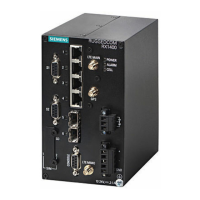RUGGEDCOM NETCONF
Reference Guide
Chapter 7
Examples
Setting a Static Route 91
</rpc>]]>]]>
5. Commit the changes:
<rpc message-id="234" xmlns="urn:ietf:params:xml:ns:netconf:base:1.0">
<commit/>
</rpc>]]>]]>
6. Unlock the candidate configuration:
<rpc xmlns="urn:ietf:params:xml:ns:netconf:base:1.0" message-id="235">
<unlock>
<target>
<candidate/>
</target>
</unlock>
</rpc>]]>]]>
7. Unlock the running configuration:
<rpc xmlns="urn:ietf:params:xml:ns:netconf:base:1.0" message-id="236">
<unlock>
<target>
<running/>
</target>
</unlock>
</rpc>]]>]]>
Section7.16
Setting a Static Route
In this example, multiple <rpc> requests set a static route in the candidate configuration and then commit the
changes.
The following is the recommended procedure for making configuration changes on a device:
1. Lock the running configuration:
<rpc xmlns="urn:ietf:params:xml:ns:netconf:base:1.0" message-id="230">
<lock>
<target>
<running/>
</target>
</lock>
</rpc>]]>]]>
2. Lock the candidate configuration:
<rpc xmlns="urn:ietf:params:xml:ns:netconf:base:1.0" message-id="231">
<lock>
<target>
<candidate/>
</target>
</lock>
</rpc>]]>]]>
3. Discard uncommitted changes:
<rpc xmlns="urn:ietf:params:xml:ns:netconf:base:1.0" message-id="232">
<discard-changes/>
</rpc>]]>]]>

